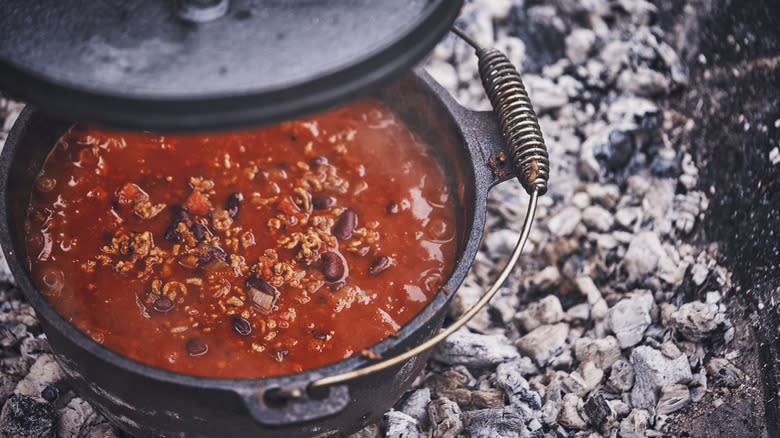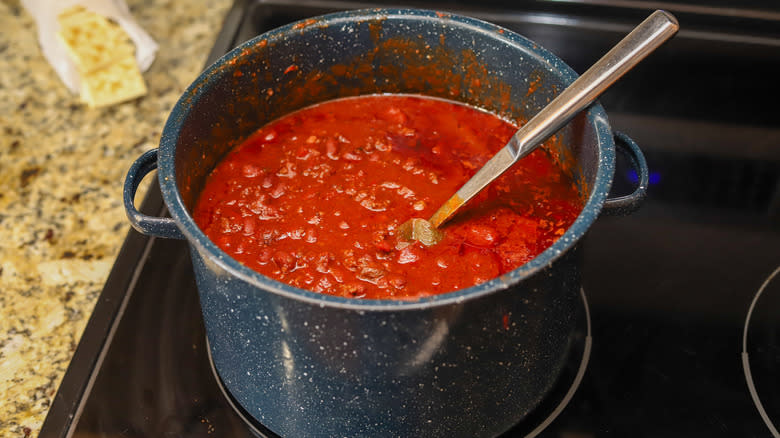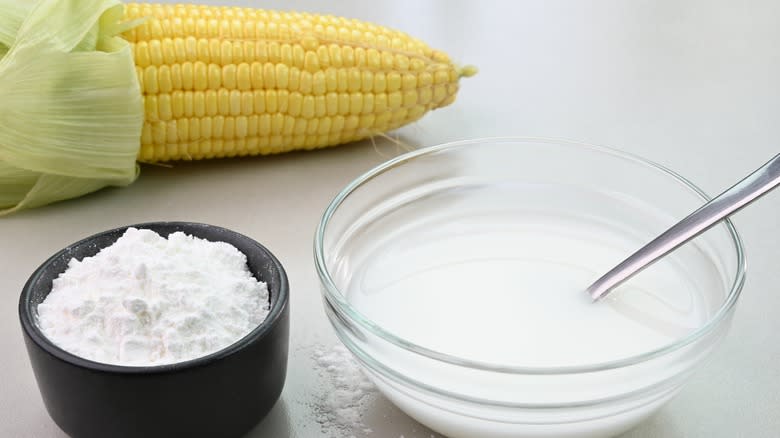The Mistake You're Making When Thickening Up Your Chili

One of the best parts of a quick and easy chili dish -- in addition to its sweet, savory, and spicy flavors -- is the delectably thick texture of the stew. When you combine its typical ingredients of meat and beans with that dense liquid base, you get a hearty dish that makes for a great meal. If you cook chili and find that your stew isn't quite thick enough, you may want to use thickening agents such as flour or cornstarch to make the stew fuller. However, you may regret adding cornstarch or flour to your chili to thicken it up, especially if you incorporate them improperly. Instead, you should actually just let your chili simmer to let the stew thicken up.
If you pour cornstarch or flour directly into your pot of chili, they will create clumps and lumps in your stew. Your chili will have an uneven texture, a less appetizing presentation, and it may be less enjoyable to eat. But if you let your chili simmer instead, your stew will benefit from a hands-free approach that will not only bulk up its texture, but also strengthen its flavor. However, just because you let your chili simmer doesn't mean your work is done. You'll have to make some adjustments to your cooking temperature.
Read more: 14 Liquids To Add To Scrambled Eggs (And What They Do)
Chili Will Thicken Up In Minutes While Simmering

The idea with simmering your chili is to leave it alone. But you'll need to adjust your burner. Leave your chili simmering on your stovetop over medium-low heat for at least five to 10 minutes. The leftover liquid will continue to cook off by evaporating and you can let it do so until your stew thickens up as much as you want it to.
Allowing your chili to simmer low and slow will also make it tastier. The extra time allows your seasonings and spices to really penetrate your stew. This will add depth to the flavor profile of your dish, making your chili even richer. Although letting your chili simmer for longer will give it a wonderful texture, you don't have to stop there. You can elevate the texture of your chili even more by using other tricks for thickening your chili, such as mixing in tomato paste or cornmeal in your stew. However, if you don't have time to let your chili simmer, you can use flour or cornstarch to thicken it up. But you must incorporate these thickening agents into your chili properly or you will regret it.
How To Thicken Chili With Flour Or Cornstarch

Incorporating cornstarch and flour in your chili recipe can make your stew denser (as well as thicken your next soup), but don't pour either directly into your chili because that will ruin its texture. You should actually first make a slurry with your thickening agent and water. After mixing the slurry properly into your chili, your stew will have a consistently thick texture. The amount of water that you use for your slurry will depend on which thickening agent you use, since the thickening agent needs to dissolve into your liquid.
If you are using cornstarch to thicken your chili, create a slurry by mixing one tablespoon of cornstarch with one tablespoon of water. Pour your cornstarch slurry mixture into your chili and make sure that you stir it evenly. If you are using flour to thicken your chili, make a slurry mixture with one tablespoon of flour and two tablespoons of water. Incorporate the slurry mixture into your chili evenly. No matter which slurry mixture you use, you should still let your chili simmer for at least 10 minutes after adding the slurry.
Read the original article on Daily Meal.

